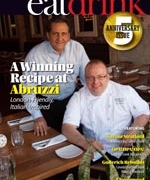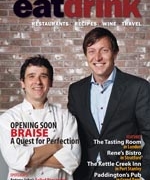Food on the Street
Street food in North America has been given a gourmet facelift over the past few years. No longer a venue for hot dogs alone, vendors selling from sidewalk carts and mobile trucks have gained fame and fortune with non-traditional street food menus. Documented in scrapbook-style, Mission Street Food: Recipes and Ideas from an Improbable Restaurant, outlines how two unlikely entrepreneurs kick-started this revolution three years ago by mingling fancy food with a rented taco cart in San Francisco. They were an internet buzz, they were a hit with food journalists, they sold out of food every night, and they transformed the restaurant scene. With a business plan that goes against all convention, the husband and wife team of Anthony Myint and Karen Leibowitz created Mission Street Food in San Francisco. Their unorthodox business plan outlines such clauses as: “The goal of Mission Street Food is to offer unpredictable eating experiences that make no profit, lose no money, and require a substantial amount of work” and “The Restaurant will not engage in any kind of mainstream promotion, such as permanent signage or a phonebook listing.” The business plan reads more like a whimsical document, but they were very serious and wildly successful in an unprecedented endeavour that impacted the food scene; hundreds of customers congregated outside the cart on opening night and the line-ups spread from there. Their unique idea gathered attention through social media when bloggers and tweeters started the buzz the morning of their opening night of business, giving rise to Mission Street Food’s success story and to street food’s popularity across the U.S.A. and Canada. And the rise has been significant in both volume of vendors and quality of food, inspiring recent shows on the Food Network such as Eat St. and The Great Food Truck Race.
The idea of Mission Street Food was born out of ingenuity by Myint, an American of Burmese descent inspired by the flavours of Asian fusion, wanting to run a restaurant of his own without taking too many risks. His solution was to rent a Guatemalan taco cart on Mission Street once a week to sell fancy sandwiches. The sandwich fillings resembled a high-end restaurant menu, the likes of crab fritters, edamame puree, pickled hon shimeji mushroom, and nori crumble on home-made flatbread. After a very short, but very successful, five nights in the food cart, their resourcefulness continued by moving operations to a run-down Chinese restaurant, called Lung Shan, on the same street. They kept their name as Mission Street Food but it took on a different inflection – going from Mission Street-Food to Mission-Street Food. Similar to the cart, they rented the building for one night a week and the name of Lung Shan remained on the outside of the building for the real owners to continue their takeout business. For that one night, Myint and Leibowitz were essentially running a restaurant inside of a restaurant with a different name, coining another unique term in the industry known as “pop-up restaurant.” Their gimmick to meet their goal of offering unpredictable eating experiences was to continue serving inventive menus that would be different each week. Customers would never know what was going to be served from one week to the next, fanning their flames of mysterious popularity further. Their online presence through a food blog kept their fans linked to their themed meals, and became their form of non-traditional advertising.
Myint wasn’t sure if this would become a weekly hobby or a career, since he was already a full-time line cook at another restaurant and Leibowitz was an English professor at Berkeley. Leibowitz gives full credit to her husband for his creative business sense by writing, “Anthony does things differently from other people; he sees possibilities where no one else does, but he’s also willing to take on projects that everyone else is too practical to even try.” Not only with the novel idea of subletting a restaurant and his creative combinations of ingredients to create never-before-seen dishes, but he then started propositioning guest chefs from other restaurants in San Francisco to cook at Mission Street Food, hoping to launch what he called “an indie-chef movement.”
Myint was also completely serious about practicing excessive philanthropy through their business – another clause in the business plans states: “If the Restaurant earns any profits, The Management will distribute it to unrelated nonprofit organizations.” They iterate time and again throughout the book that all profits from Mission Street Food go to hunger-related charities; the proceeds from the sales of the book itself are donated to Slow Food USA.
Street food’s popularity stems from many things, including the novelty of getting gourmet food from a street cart historically reserved for hot dogs, as well as the modern use of social media to draw crowds to their transient locations. Another factor leading to its success is the easier connectivity to the owners. Compared to the dissociation between diners and chefs in traditional restaurants – we just don’t see the kitchens and the work that goes into preparing our meal – the food trucks give a closer interaction. As one customer explained about Mission Street Food: “It’s fun to talk to the guy whose cart it is. It’s fun to talk to the other customers. We’re in line for the same thing, I guess. It’s like we exchanged our money for something more than just food.”
Aside from detailing the history behind the business of Mission Street Food, the book called Mission Street Food is a melange of recipes, cooking techniques, photos, and food essays written in tandem by Myint and Leibowitz. While reading it, you learn that Mission Street Food is difficult to explain because it has become such an assortment of business ventures that build off one another – a taco truck, a food blog, a burger stand, a charity, a pop-up restaurant, but most of all, a wacky vision fuelled by creativity that changed the face of street food.










